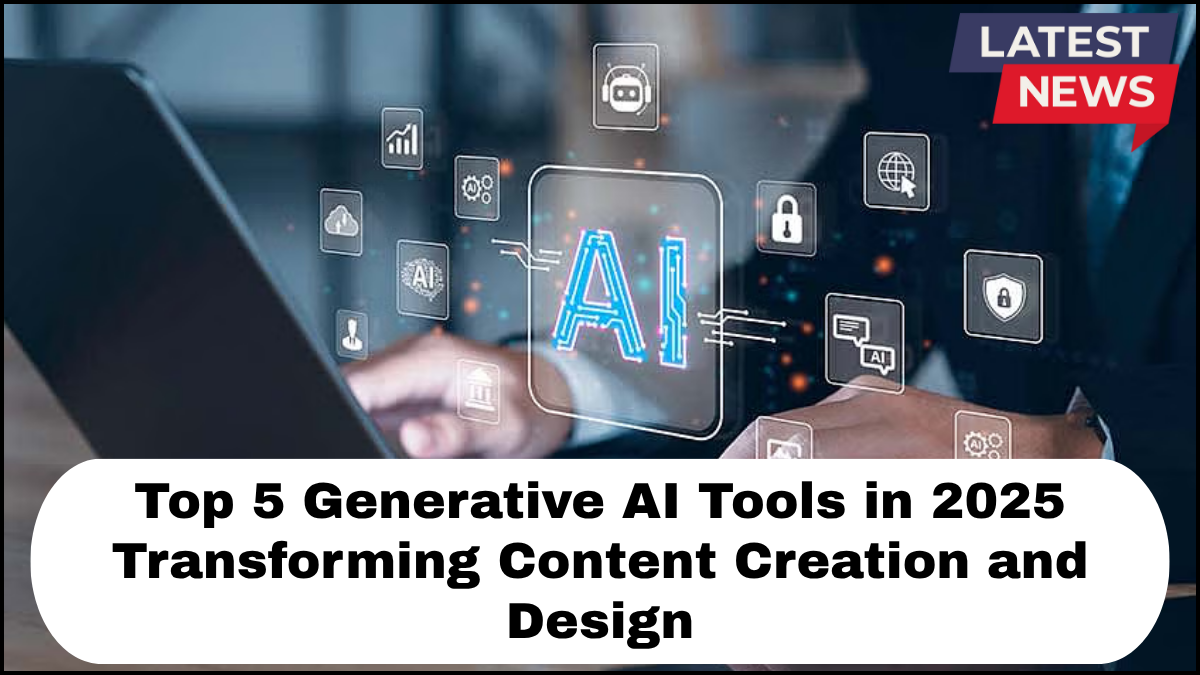The rise of generative AI tools in 2025 is reshaping the way we create, design, and communicate ideas. No longer just novelty features, these tools have matured into essential assets for marketers, designers, writers, and developers. Whether you’re crafting high-converting copy or designing product mockups, the latest wave of AI content creation apps delivers precision, speed, and creative power like never before.

Below are the top 5 generative AI tools making the biggest impact this year—and why they matter.
1. OpenAI Sora: Redefining Video Production
What it does:
OpenAI’s Sora enables users to generate realistic, dynamic video clips from simple text prompts. It combines image synthesis, motion capture, and AI editing tools to produce cinematic-quality visuals in minutes.
Why it matters in 2025:
Video marketing is non-negotiable for brands, but production costs have been a barrier. Sora removes that obstacle, making it one of the most disruptive generative AI tools in 2025. It democratizes storytelling for creators and businesses of all sizes.
Use case example:
A digital agency can now pitch ad campaigns using AI-generated video prototypes, slashing the time from concept to client presentation.
2. Adobe Firefly 3: AI for Designers, Finally Done Right
What it does:
Firefly 3 integrates tightly into Adobe’s Creative Cloud ecosystem, allowing designers to generate vector graphics, social media templates, and even branded illustrations using natural language.
What’s new in 2025:
With enhanced style transfer, multi-modal input (text + image), and real-time brand consistency checks, Firefly 3 is a powerhouse for content creation workflows.
Why it stands out:
Unlike other tools that merely assist, Firefly 3 collaborates with the designer. It’s not just a prompt-and-wait tool—it’s iterative and responsive.
Use case example:
A freelance graphic designer can rapidly mock up five campaign variants for different audiences, all while maintaining the client’s brand guidelines.
3. Jasper AI 2025: Enterprise-Grade Content at Scale
What it does:
Jasper has evolved into a robust AI writing platform tailored for enterprise needs. It handles SEO blog writing, email sequences, ad copy, and even long-form articles.
New in 2025:
Its latest update introduces campaign orchestration tools and native CMS integrations, making it a top-tier AI content creation app for large teams.
Why it’s essential:
Marketing teams don’t just need fast content—they need aligned, on-brand, optimized content. Jasper delivers on all fronts.
Use case example:
A B2B SaaS company can deploy Jasper to generate region-specific product pages in multiple languages while keeping tone and structure consistent.
4. Runway ML Gen-3: Real-Time Creative Collaboration
What it does:
Runway ML has taken a massive leap with Gen-3, offering AI-powered video editing, animation, and storytelling—all inside a browser.
Why it leads in 2025:
Its new real-time collaboration mode allows teams to edit scenes, tweak narrative flow, and apply style changes together, making it perfect for remote creative teams.
Distinctive feature:
Gen-3 can simulate camera movements, lighting effects, and even voice acting, positioning it as one of the most complete generative AI tools in 2025.
Use case example:
A YouTube production team can storyboard, edit, and animate episodes in-browser, cutting traditional post-production time by over 60%.
5. Canva Magic Studio: AI-Powered Simplicity for Everyone
What it does:
Magic Studio takes Canva’s user-friendly design interface and supercharges it with AI features—automatic copywriting, smart layouts, brand voice matching, and generative presentations.
2025 Upgrades:
Now featuring AI video synthesis and 3D product mockups, Canva isn’t just for beginners anymore. It’s rapidly becoming a full-service creative suite.
Why it’s transformative:
It bridges the gap between simplicity and professional output, making it a go-to AI content creation app for startups, educators, and solopreneurs.
Use case example:
An e-commerce seller can auto-generate product banners, A+ content, and video ads with a few clicks—without ever opening Adobe tools.
Final Thoughts
As generative AI tools in 2025 continue to evolve, the divide between imagination and execution is shrinking fast. These tools aren’t just about automating content—they’re about enhancing creativity, improving collaboration, and driving results at scale. Whether you’re a designer, marketer, or entrepreneur, leveraging these AI solutions isn’t optional—it’s a competitive edge.
Frequently Asked Questions
1. What are generative AI tools used for in 2025?
Generative AI tools in 2025 are used for creating written content, images, videos, designs, and even audio based on user prompts. They’re widely adopted in marketing, design, education, software development, and content creation industries.
2. Are AI content creation apps reliable for professional use?
Yes, modern AI content creation apps like Jasper, Canva Magic Studio, and Adobe Firefly 3 offer professional-grade outputs. They support brand consistency, SEO best practices, and cross-platform content deployment.
3. How do generative AI tools help teams work faster?
These tools automate time-consuming tasks like drafting, editing, visual generation, and formatting. They also enhance team workflows through collaborative features and seamless integrations with CMS and design software.
4. Which generative AI tool is best for video creation in 2025?
OpenAI’s Sora and Runway ML Gen-3 are leading the space for AI video generation. Sora excels at cinematic realism, while Runway ML shines in real-time collaboration and animation.
5. Can small businesses benefit from generative AI tools?
Absolutely. Tools like Canva Magic Studio and Jasper AI offer affordable, user-friendly platforms that level the playing field for small businesses, helping them produce high-quality content without needing large creative teams.
click here to learn more
